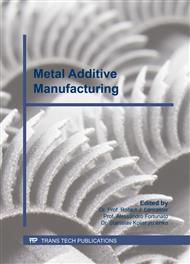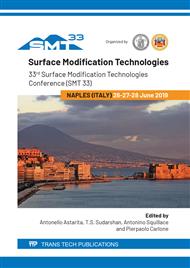[1]
ASTM F2792, Standard Specification for Additive Manufacturing Titanium-6 Aluminum-4 Vanadium with Powder Bed Fusion.
DOI: 10.1520/f2924-14r21
Google Scholar
[2]
A. Uriondo, M. Esperon-Miguez, S. Perinpanayagam, The present and future of additive manufacturing in the aerospace sector: A review of important aspects, Proceedings IMechE Part G: J. Aerospace Engineering 0(0) (2015) 1-16.
DOI: 10.1177/0954410014568797
Google Scholar
[3]
X. Gong, T. Anderson, K. Chou, Review on powder-based electron beam additive manufacturing technology, Manuf. Rev. 1 (2014) 1-10.
Google Scholar
[4]
C. Koerner, Additive manufacturing of metallic components by selective electron beam melting — a review, Int. Mater. Rev. 61 (2016) 361-377.
DOI: 10.1080/09506608.2016.1176289
Google Scholar
[5]
L. Facchini, E. Magalini, P. Robotti, A. Molinari, Microstructure and mechanical properties of Ti-6Al-4V produced by electron beam melting of pre-alloyed powders, Rapid Prototyping Journal 15 (2009) 171–178.
DOI: 10.1108/13552540910960262
Google Scholar
[6]
V. Popov, A. Katz-Demyanetz, A. Garkun, G. Muller, E. Strokin, H. Rosenson, Effect of Hot Isostatic Pressure treatment on the Electron-Beam Melted Ti-6Al-4V specimens, Procedia Manufacturing 21 (2018) 125-132.
DOI: 10.1016/j.promfg.2018.02.102
Google Scholar
[7]
C. Pirozzi, R. Borrelli, S. Franchitti, F. Caiazzo, V. Alfieri, P. Argenio, Study on the Factors Affecting the Mechanical Behavior of Electron Beam Melted Ti6Al4V, Journal of Materials Engineering and Performance 26 Issue 9 (2017), 4491-4499, DOI 10.1007/s11665-017-2894-1.
DOI: 10.1007/s11665-017-2894-1
Google Scholar
[8]
R. N. Wenzel, Resistance of solid surfaces to wetting by water,, Industrial and engineering chemistry 28 (1936) 988.
Google Scholar
[9]
R. Borrelli, S. Franchitti, C. Pirozzi, L. Carrino, L. Nele, W. Polini, L. Sorrentino, A. Corrado, Ti6Al4V Parts Produced by Electron Beam Melting: Analysis of Dimensional Accuracy and Surface Roughness, Journal of Advanced Manufacturing Systems (2019) in press.
DOI: 10.1142/s0219686720500067
Google Scholar
[10]
ASTM D724, Standard Test Method for Surface Wettability of Paper (Angle-of-Contact Method).
Google Scholar
[11]
S. Wang, L. Jiang, Definition of superhydrophobic states, Advanced Materials 19 (21) (2007) 3423-3424.
DOI: 10.1002/adma.200700934
Google Scholar



